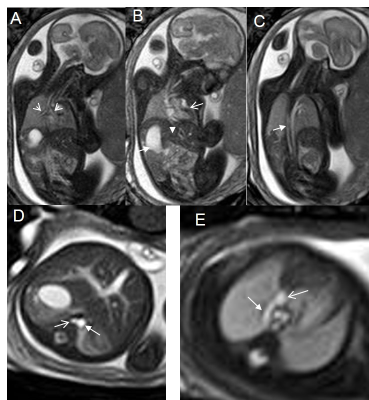Fetal Cardiac MR
1Shanghai Children's Medical Center, School of Medicine, Shanghai Jiao Tong University, Shanghai, China, 2Radiology, Shanghai Children's Medical Center, School of Medicine, Shanghai Jiao Tong University, Shanghai, China
Synopsis
The objective of this presentation is to provide an overview of fetal cardiac MR imaging methods and their applications in congenital heart disease.
The objective of this presentation is to provide an overview of fetal cardiac MR imaging methods and their applications in congenital heart disease.
This talk will cover recent technical advances in fetal CMR, fetal normal cardiovascular image signs and appearances of various structural congenital heart disease on fetal CMR. We will review the embryology and anatomy of the heart. We will cover fetal CMR technique (such as gating, imaging sequences including SSFP, SSTSE, real-time non gated SSFP and PC Cine sequences et al) and evaluation of congenital heart disease (anatomic segmental approach). We will present fetal normal CMR imaging and multiple imaging examples of congenital heart disease.Acknowledgements
This work was supported by National Natural Science Foundation of China (81971582, 81571628, 81101032), Natural Science Foundation of Shanghai (19ZR1476700), Shanghai Pujiang Program (2019PJD030) and Shanghai Municipal Commission of Health and Family Planning Program (201540048)References
1.Dong SZ, Zhu M, Li F. Preliminary experience with cardiovascular magnetic resonance in evaluation of fetal cardiovascular anomalies. J Cardiovasc Magn Reson. 2013 May 21;15(1):40 2.Dong SZ, Zhu M. Pattern-based approach to fetal congenital cardiovascular anomalies using the transverse aortic arch view on prenatal cardiac MRI. Pediatr Radiol. 2015 Apr;45(5):743-50 3.Roy CW, Seed M, Kingdom JC, Macgowan CK. Motion compensated cine CMR of the fetal heart using radial undersampling and compressed sensing. J Cardiovasc Magn Reson. 2017 Mar 20;19(1):29 4.Lloyd DFA, Pushparajah K, Simpson JM, van Amerom JFP, van Poppel MPM, Schulz A, et al. Three-dimensional visualisation of the fetal heart using prenatal MRI with motion-corrected slice-volume registration: a prospective, single-centre cohort study. Lancet. 2019 Apr 20;393(10181):1619-1627 5.Goolaub DS, Xu J, Schrauben E, Sun L, Roy CW, Marini D, et al. Fetal Flow Quantification in Great Vessels Using Motion-Corrected Radial Phase Contrast MRI: Comparison With Cartesian. J Magn Reson Imaging. 2021 Feb;53(2):540-551
